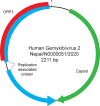This is a preprint.
Gemykibivirus detection in acute encephalitis patients from Nepal
- PMID: 38405898
- PMCID: PMC10889008
- DOI: 10.1101/2024.02.13.24302648
Gemykibivirus detection in acute encephalitis patients from Nepal
Update in
-
Gemykibivirus detection in acute encephalitis patients from Nepal.mSphere. 2024 Jul 30;9(7):e0021924. doi: 10.1128/msphere.00219-24. Epub 2024 Jun 21. mSphere. 2024. PMID: 38904383 Free PMC article.
Abstract
Acute Encephalitis Syndrome (AES) causes significant morbidity and mortality worldwide. In Nepal, Japanese encephalitis virus (JEV) accounts for ~ 5-20% of AES cases, but ~75% of AES cases are of unknown etiology. We identified a gemykibivirus in CSF collected in 2020 from a male child with AES using metagenomic next-generation sequencing. Gemykibiviruses are single stranded, circular DNA viruses in the family Genomoviridae. The complete genome of 2211 nucleotides was sequenced which shared 98.69% nucleotide identity to its closest relative, Human associated gemykibivirus 2 isolate SAfia-449D. Two real-time PCR assays were designed, and screening of 337 CSF and 164 serum samples from AES patients in Nepal collected in 2020 and 2022 yielded 11 CSF and 1 serum sample that were positive in both PCR assays. Complete genomes of 7 of the positives were sequenced. These results identify a candidate etiologic agent of encephalitis in Nepal.
Keywords: Gemykibivirus; acute encephalitis syndrome; emerging infection; metagenomic analysis.
Figures




References
-
- Why encephalitis matters? Report of the virtual meeting, 28–29 June 2022. Geneva: World Health Organization; 2023.
-
- Wang H, Zhao S, Wang S, Zheng Y, Wang S, Chen H, et al. Global magnitude of encephalitis burden and its evolving pattern over the past 30 years. J Infect. 2022. Jun;84(6):777–87. - PubMed
-
- Department of Health Services Annual Report 2078/79. Kathmandu: Government of Nepal Ministry of Health and Population; 2021/2022.
-
- Granerod J, Cunningham R, Zuckerman M, Mutton K, Davies NW, Walsh AL, et al. Causality in acute encephalitis: defining aetiologies. Epidemiol Infect. 2010. Jun;138(6):783–800. - PubMed
-
- Glaser CA, Honarmand S, Anderson LJ, Schnurr DP, Forghani B, Cossen CK, et al. Beyond viruses: clinical profiles and etiologies associated with encephalitis. Clin Infect Dis. 2006. Dec 15;43(12):1565–77. - PubMed
Publication types
Grants and funding
LinkOut - more resources
Full Text Sources
